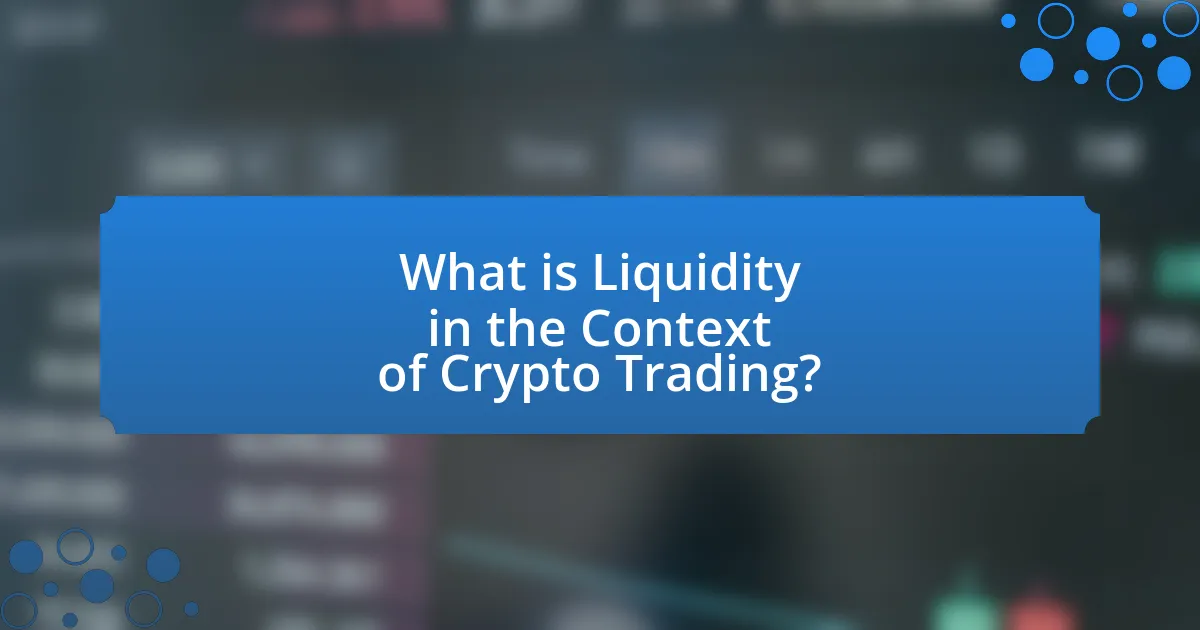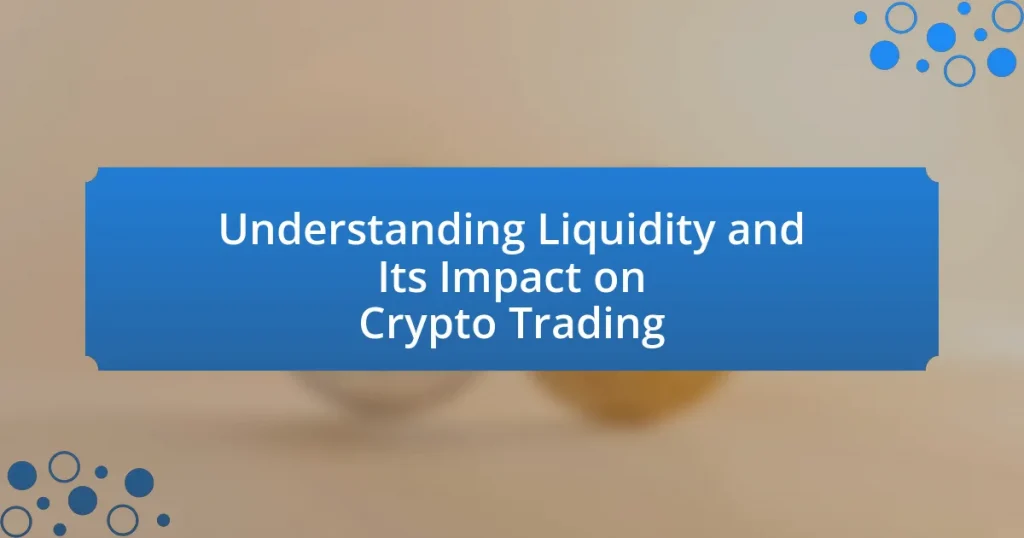Liquidity in crypto trading refers to the ease of buying or selling cryptocurrencies without causing significant price changes. This article explores the definition of liquidity, its characteristics, and its importance in trading strategies. It highlights the differences between liquidity in traditional and crypto markets, the factors influencing liquidity, and the risks associated with low liquidity. Additionally, it discusses how traders can assess liquidity, mitigate risks, and enhance trading performance through effective strategies and best practices. Understanding these aspects is crucial for navigating the complexities of the crypto trading landscape.

What is Liquidity in the Context of Crypto Trading?
Liquidity in the context of crypto trading refers to the ease with which a cryptocurrency can be bought or sold in the market without causing significant price fluctuations. High liquidity indicates that there are many buyers and sellers, allowing for quick transactions at stable prices, while low liquidity can lead to larger price swings and difficulty in executing trades. For example, Bitcoin typically exhibits high liquidity due to its widespread adoption and trading volume, whereas lesser-known altcoins may experience low liquidity, making it challenging to execute trades without impacting their market price.
How is liquidity defined in financial markets?
Liquidity in financial markets is defined as the ease with which an asset can be bought or sold in the market without affecting its price. High liquidity indicates that there are many buyers and sellers, allowing for quick transactions at stable prices, while low liquidity can lead to price volatility and difficulty in executing trades. For example, major stocks typically exhibit high liquidity due to their large trading volumes, whereas niche assets may have lower liquidity, making them harder to trade efficiently.
What are the key characteristics of liquidity?
The key characteristics of liquidity include the ease of buying or selling an asset without causing a significant impact on its price, the speed at which transactions can be executed, and the availability of market participants to facilitate trades. High liquidity indicates a market where assets can be quickly converted to cash, often characterized by tight bid-ask spreads and high trading volumes. For example, in cryptocurrency markets, Bitcoin typically exhibits high liquidity due to its widespread acceptance and trading activity, allowing for rapid transactions with minimal price fluctuations.
How does liquidity differ between traditional and crypto markets?
Liquidity in traditional markets is generally higher than in crypto markets due to the presence of established financial institutions and regulatory frameworks that facilitate trading. Traditional markets, such as stock exchanges, benefit from a large number of participants and standardized trading hours, which contribute to consistent liquidity. In contrast, crypto markets often experience significant volatility and lower trading volumes, leading to wider bid-ask spreads and less predictable liquidity. For example, during periods of high market activity, the average daily trading volume for Bitcoin can reach around $30 billion, while smaller cryptocurrencies may see volumes below $1 million, illustrating the disparity in liquidity across different assets.
Why is liquidity important for crypto traders?
Liquidity is important for crypto traders because it determines how easily assets can be bought or sold without significantly affecting their price. High liquidity allows traders to execute large orders quickly and at stable prices, reducing the risk of slippage, which occurs when the execution price differs from the expected price. For instance, in highly liquid markets like Bitcoin, traders can enter and exit positions rapidly, facilitating efficient trading strategies. Conversely, low liquidity can lead to increased volatility and difficulty in executing trades, which can result in losses. According to a report by CoinMarketCap, liquidity is a critical factor influencing trading volume and market stability, underscoring its significance in the crypto trading landscape.
How does liquidity affect trading costs?
Liquidity directly affects trading costs by influencing the bid-ask spread and execution prices. In highly liquid markets, the bid-ask spread is narrower, which reduces the cost of entering and exiting trades. For example, in the cryptocurrency market, Bitcoin often exhibits lower trading costs due to its high liquidity, with spreads as low as 0.1% compared to less liquid assets that may have spreads exceeding 1%. This difference in liquidity leads to more efficient price discovery and lower slippage, ultimately minimizing the overall trading costs for participants.
What role does liquidity play in price stability?
Liquidity plays a crucial role in price stability by enabling efficient market transactions and reducing volatility. High liquidity allows for quicker execution of trades without significantly impacting the asset’s price, which helps maintain stable prices even during large buy or sell orders. For instance, in cryptocurrency markets, assets with higher liquidity tend to experience less price fluctuation compared to those with lower liquidity, as evidenced by Bitcoin’s relatively stable price movements during periods of high trading volume. This relationship underscores the importance of liquidity in fostering a stable trading environment, as it mitigates the risk of sharp price swings that can occur in less liquid markets.
What factors influence liquidity in crypto trading?
Liquidity in crypto trading is influenced by several key factors, including trading volume, market depth, and the number of active participants. High trading volume indicates a greater number of transactions, which typically enhances liquidity by allowing assets to be bought and sold more easily. Market depth refers to the volume of buy and sell orders at various price levels; deeper markets can absorb larger trades without significantly impacting the price, thus improving liquidity. Additionally, a larger number of active participants, including retail and institutional investors, contributes to liquidity by increasing the frequency of trades and the diversity of orders in the market. These factors collectively determine how easily assets can be traded without causing drastic price changes.
How do market participants impact liquidity?
Market participants significantly impact liquidity by influencing the supply and demand dynamics within a market. When a large number of buyers and sellers are active, liquidity increases, allowing for quicker transactions and smaller price fluctuations. Conversely, when market participants withdraw or reduce their trading activity, liquidity decreases, leading to wider spreads and potential price volatility. For example, during periods of high trading volume, such as major cryptocurrency announcements or market events, liquidity tends to improve, facilitating smoother trades. In contrast, during low activity periods, such as weekends or holidays, liquidity can diminish, resulting in less favorable trading conditions.
What external factors can affect liquidity levels?
External factors that can affect liquidity levels include market conditions, regulatory changes, and macroeconomic indicators. Market conditions, such as volatility and trading volume, directly influence how easily assets can be bought or sold without impacting their price. Regulatory changes, like new laws or guidelines affecting cryptocurrency trading, can either enhance or restrict market participation, thereby affecting liquidity. Macroeconomic indicators, such as interest rates and inflation, also play a role; for instance, higher interest rates may lead to reduced investment in riskier assets like cryptocurrencies, decreasing liquidity.

How Does Liquidity Impact Crypto Trading Strategies?
Liquidity significantly impacts crypto trading strategies by determining the ease with which assets can be bought or sold without affecting their price. High liquidity allows traders to execute large orders quickly at stable prices, reducing slippage and enabling more effective risk management. Conversely, low liquidity can lead to increased volatility and larger price swings, making it challenging for traders to enter or exit positions without incurring significant costs. For instance, during periods of low liquidity, a trader attempting to sell a large amount of a cryptocurrency may find that the market price drops sharply due to insufficient buy orders, thereby affecting their overall trading strategy and profitability.
What trading strategies are influenced by liquidity?
Trading strategies influenced by liquidity include market making, arbitrage, and trend following. Market making relies on the ability to buy and sell assets quickly, benefiting from the spread between bid and ask prices, which is directly affected by liquidity levels. Arbitrage strategies exploit price discrepancies across different markets, requiring sufficient liquidity to execute trades without significant price impact. Trend following strategies depend on the ability to enter and exit positions efficiently, which is facilitated by high liquidity, allowing traders to capitalize on price movements without causing large fluctuations. These strategies demonstrate that liquidity is a critical factor in determining the effectiveness and profitability of various trading approaches.
How do high liquidity environments affect day trading?
High liquidity environments enhance day trading by allowing traders to execute large orders quickly without significantly impacting the asset’s price. In such environments, the presence of numerous buyers and sellers ensures tighter bid-ask spreads, which reduces trading costs and increases the potential for profit. For instance, during periods of high liquidity, the average bid-ask spread for major cryptocurrencies can narrow to as low as 0.1%, compared to wider spreads in low liquidity conditions. This facilitates faster entry and exit points for traders, enabling them to capitalize on short-term price movements more effectively.
What strategies are best suited for low liquidity conditions?
In low liquidity conditions, strategies such as limit orders, market making, and utilizing algorithmic trading are best suited. Limit orders allow traders to set specific prices for buying or selling assets, reducing the impact of price slippage that often occurs in low liquidity markets. Market making involves providing liquidity by placing buy and sell orders, which can help stabilize prices and create opportunities for profit. Algorithmic trading can optimize execution by analyzing market conditions and executing trades at the best possible prices, minimizing the risks associated with low liquidity. These strategies are effective because they help manage the inherent risks and inefficiencies present in low liquidity environments, allowing traders to navigate these conditions more successfully.
How can traders assess liquidity in crypto markets?
Traders can assess liquidity in crypto markets by analyzing trading volume, order book depth, and bid-ask spreads. High trading volume indicates active participation and ease of executing trades without significant price changes. Order book depth reveals the number of buy and sell orders at various price levels, helping traders understand how much liquidity is available at specific prices. Additionally, narrow bid-ask spreads suggest a more liquid market, as they reflect lower transaction costs and quicker execution times. For instance, a cryptocurrency with a daily trading volume exceeding $100 million typically demonstrates higher liquidity compared to one with only $1 million in daily trades.
What metrics are used to measure liquidity?
The primary metrics used to measure liquidity include the bid-ask spread, trading volume, and market depth. The bid-ask spread indicates the difference between the highest price a buyer is willing to pay and the lowest price a seller will accept, reflecting the cost of executing a trade. Trading volume represents the total number of assets traded over a specific period, providing insight into market activity and interest. Market depth assesses the quantity of buy and sell orders at various price levels, illustrating the market’s ability to absorb large trades without significantly impacting the price. These metrics are essential for evaluating the efficiency and stability of a market, particularly in the context of crypto trading, where liquidity can vary widely.
How can order book analysis provide insights into liquidity?
Order book analysis provides insights into liquidity by revealing the depth and breadth of buy and sell orders at various price levels. This analysis allows traders to assess how easily an asset can be bought or sold without significantly impacting its price. For instance, a thick order book with numerous orders at close price levels indicates high liquidity, as it suggests that large trades can be executed with minimal price slippage. Conversely, a thin order book with few orders signals low liquidity, which can lead to greater price volatility when trades occur. Historical data shows that assets with higher liquidity tend to have tighter bid-ask spreads, making them more attractive for trading.

What Are the Risks Associated with Low Liquidity in Crypto Trading?
Low liquidity in crypto trading poses significant risks, including increased price volatility and difficulty executing trades. When liquidity is low, large orders can lead to substantial price swings, as there may not be enough buyers or sellers to absorb the trade without impacting the market price. For instance, a study by the Bank for International Settlements in 2020 highlighted that low liquidity can exacerbate price movements, making it challenging for traders to enter or exit positions without incurring significant losses. Additionally, low liquidity can result in wider bid-ask spreads, increasing trading costs and reducing overall market efficiency.
What challenges do traders face in low liquidity scenarios?
Traders face significant challenges in low liquidity scenarios, primarily including increased price volatility and difficulty executing trades at desired prices. In low liquidity markets, the lack of sufficient buy and sell orders can lead to larger price swings, as even small trades can disproportionately affect market prices. For instance, a study by the Bank for International Settlements in 2020 highlighted that low liquidity can result in bid-ask spreads widening, making it more expensive for traders to enter or exit positions. Additionally, traders may experience slippage, where the executed price differs from the expected price due to insufficient market depth. This combination of factors can lead to increased trading costs and heightened risk, ultimately impacting traders’ profitability and decision-making in the crypto market.
How does low liquidity lead to increased volatility?
Low liquidity leads to increased volatility because it results in fewer buy and sell orders in the market, making it easier for price fluctuations to occur. When there are not enough participants to absorb trades, even small transactions can cause significant price changes. For instance, in a market with low liquidity, a single large sell order can drastically lower the price, while a large buy order can spike it. This phenomenon is evident in cryptocurrency markets, where assets often experience sharp price swings due to limited trading volume. Historical data shows that cryptocurrencies like Bitcoin and Ethereum can exhibit extreme volatility during periods of low liquidity, as seen during market downturns or when trading volumes drop significantly.
What are the implications of slippage in low liquidity markets?
Slippage in low liquidity markets leads to significant price discrepancies between expected and actual trade execution prices. This occurs because, in low liquidity environments, there are fewer buy and sell orders, causing larger price movements when trades are executed. For instance, a trader attempting to sell a large volume of an asset may find that the available buy orders at the desired price are insufficient, resulting in the trade being executed at a lower price than anticipated. This phenomenon can increase trading costs and reduce profitability, as evidenced by studies showing that slippage can range from 0.5% to over 5% in low liquidity conditions, depending on the asset and market dynamics.
How can traders mitigate risks related to liquidity?
Traders can mitigate risks related to liquidity by employing strategies such as diversifying their asset portfolio, utilizing limit orders, and conducting thorough market analysis. Diversification reduces exposure to any single asset’s liquidity risk, as holding a variety of assets can provide more opportunities for trading without significant price impact. Using limit orders allows traders to set specific prices at which they are willing to buy or sell, thus avoiding unfavorable market conditions that can arise from high volatility or low liquidity. Additionally, conducting market analysis helps traders identify liquidity trends and select trading times when liquidity is higher, thereby minimizing the risk of executing trades at unfavorable prices.
What best practices should traders follow to manage liquidity risks?
Traders should implement several best practices to effectively manage liquidity risks, including maintaining a diversified portfolio, utilizing limit orders, and regularly monitoring market conditions. Diversifying a portfolio across various assets reduces the impact of liquidity issues in any single asset, as evidenced by studies showing that diversified portfolios can mitigate risk exposure. Utilizing limit orders allows traders to set specific price points for buying or selling, which can prevent unfavorable trades during periods of low liquidity. Additionally, regularly monitoring market conditions helps traders stay informed about liquidity trends and potential market disruptions, enabling timely adjustments to their strategies.
How can diversification help in liquidity management?
Diversification enhances liquidity management by spreading investments across various assets, which reduces the risk of liquidity shortages. When an investor holds a diverse portfolio, the likelihood of all assets experiencing low liquidity simultaneously decreases, allowing for smoother transactions and better access to cash when needed. For instance, during market downturns, certain assets may retain their value or liquidity better than others, providing a buffer against overall portfolio declines. This strategy is supported by historical data showing that diversified portfolios tend to have lower volatility and better risk-adjusted returns, which ultimately aids in maintaining liquidity.
What practical tips can enhance trading performance in relation to liquidity?
To enhance trading performance in relation to liquidity, traders should focus on executing trades during peak market hours when liquidity is highest, as this reduces slippage and improves order execution. Additionally, utilizing limit orders instead of market orders allows traders to control the price at which they buy or sell, further optimizing their trades in liquid markets. Research indicates that trading during high liquidity periods can lead to better price stability and lower transaction costs, as evidenced by data showing that average spreads narrow significantly during these times. Furthermore, monitoring liquidity metrics, such as the bid-ask spread and order book depth, can provide insights into market conditions, enabling traders to make informed decisions.


